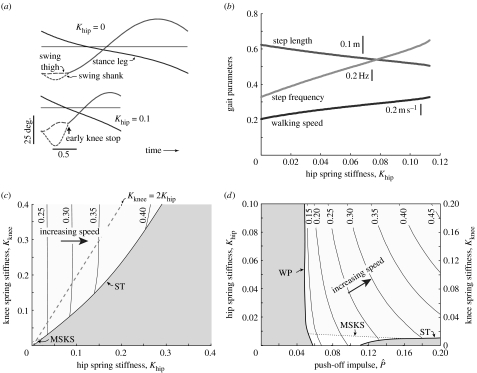Figure 6.
Uni-articular knee and hip springs together produce faster walking. (a) For a model with a knee spring (figure 4), the addition of a hip spring causes a faster step with increased knee flexion (parameters: , Kknee=0.1). (b) Dimensionless gait parameters as a function of hip spring stiffness, keeping push-off impulse and knee stiffness fixed. Increasing hip stiffness produces higher step frequencies and lower step lengths, and overall faster walking speeds. (c) Contour plot of speed as a function of the two stiffnesses, showing that stumbling (ST) can occur with high hip stiffness, denoted by the grey region to the right of the stumbling (ST) boundary (parameter: ). Stumbling can, however, be avoided if knee stiffness is increased concurrently, but most of these gaits are characterized by the knee reaching full extension before mid-stance, making them prone to foot scuffing. This can be avoided only with very low hip and knee stiffnesses, below the MSKS boundary. (d) Contour plot of speed as a function of push-off and both stiffnesses changing in proportion (Kknee=2Khip as shown in (c)). Here stumbling can easily be avoided, and high walking speeds can be produced. Except at the lowest stiffnesses, most uni-articular spring combinations here (above the MSKS boundary) cause foot scuffing.

